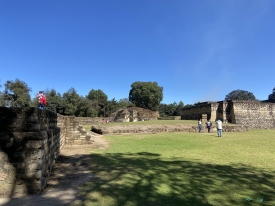ABOUT Iximche
Iximcheʼ (/iʃimˈtʃeʔ/) (or Iximché using Spanish orthography) is a Pre-Columbian Mesoamerican archaeological site in the western highlands of Guatemala. Iximche was the capital of the Late Postclassic Kaqchikel Maya kingdom from 1470 until its abandonment in 1524. The architecture of the site included a number of pyramid-temples, palaces and two Mesoamerican ballcourts. Excavators uncovered the poorly preserved remains of painted murals on some of the buildings and ample evidence of human sacrifice. The ruins of Iximche were declared a Guatemalan National Monument in the 1960s. The site has a small museum displaying a number of pieces found there, including sculptures and ceramics. It is open daily.For many years the Kaqchikel served as loyal allies of the Kʼicheʼ Maya. The growing power of the Kaqchikel within the alliance eventually caused such friction that the Kaqchikel were forced to flee the Kʼicheʼ capital and found the city of Iximche. The Kaqchikel established their new capital upon an easily defensible ridge almost surrounded by deep ravines. Iximche developed quickly as a city and within 50 years of its foundation it had reached its maximum extent. The rulers of Iximche were four principal lords drawn from the four main clans of the Kaqchikel, although it was the lords of the Sotzʼil and Xahil clans who held the real power.After the initial establishment of Iximche, the Kʼicheʼ left the Kaqchikel in peace for a number of years. The peace did not last and the Kaqchikel soundly defeated their former overlords around 1491. This was followed by infighting among the Kaqchikel clans with the rebel clans finally being overcome in 1493. Wars against the Kʼicheʼ continued throughout the early 16th century. When the Spanish conquistadors arrived in Mexico, the Aztec emperor sent messengers to warn the Kaqchikel. After the surrender of the Aztecs to Hernán Cortés, Iximche sent its own messengers to offer a Kaqchikel alliance with the Spanish. Smallpox decimated the population of Iximche before the physical arrival of the Europeans. At the time of the Spanish Conquest Iximche was the second most important city in the Guatemalan Highlands, after the Kʼicheʼ capital at Qʼumarkaj. Conquistador Pedro de Alvarado was initially well received in the city in 1524 and the Kaqchikel kings provided the Spanish with native allies to assist in the conquest of the other highland Maya kingdoms. Iximche was declared the first capital of the Kingdom of Guatemala in the same year. Due to excessive Spanish demands for tribute the Kaqchikel soon broke the alliance and deserted their capital, which was burned 2 years later by Spanish deserters. The Europeans founded a new town nearby but abandoned it in 1527 due to the continued hostility of the Kaqchikel, who finally surrendered in 1530.The ruins of Iximche were first described by a Guatemalan historian in the late 17th century. They were visited various times by scholars during the 19th century, who published plans and descriptions. Serious investigations of the site started in the 1940s and continued sporadically until the early 1970s. In 1980, during the Guatemalan Civil War, a meeting took place at the ruins between guerillas and Maya leaders that resulted in the guerillas stating that they would defend indigenous rights. A ritual was carried out at the site in 1989 in order to reestablish the ruins as a sacred place for Maya ceremonies. United States President George W. Bush visited the site in 2007, and in the same year Iximche was the venue for the III Continental Summit of Indigenous Peoples and Nationalities of Abya Yala.














